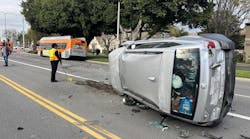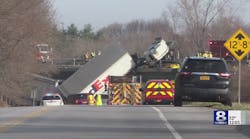Topic: Winch Skills Update
Objective: Review winch skills and competences
Task: The rescue team shall establish winch skills and competencies that can be used when responding to incidents with a vehicle that has a rescue winch.
In Part 1 of our Winch Operations Skills Update, we looked at essential skills and competencies, including winch line construction, care and maintenance, plus winch power output ratings. In Part 2, we focus on safe and effective winch rigging at incident scenes. This article also provides a brief winch skills training checklist to assist departments with their winch training efforts.
Snatch-block operations
With the addition of one simple tool, the rescue crew can practically double the pulling capacity of their winch, regardless of how much line is out. That tool is a snatch block and it works because of a principle called mechanical advantage. Having at least one rated snatch block is essential for any rescue team that has winch capability. The snatch block is essentially a rotating wheel (sheave) mounted on an axle and suspended inside a casing (block). One side of the snatch block casing opens up to allow the line from the winch to be inserted onto the wheel.
One basic rule to ensure proper matching of a snatch block to the wire rope on a winch involves maintaining a 12:1 ratio of the diameter of the sheave on the snatch block to the diameter of the winch line. For example, a 3/8-inch wire rope winch line would be matched to a snatch block with a 4½-inch diameter sheave. The math behind this is 3/8 inches multiplied by 12 equals 4.56 inches (12:1 ratio). A smaller size sheave will damage the wire rope due to its narrower grooves and smaller turning radius that can pinch the line as it is run into the groove of block. Too large a block offers no support to the wire rope.
In addition to matching sheave size to the diameter of the winch line, the manufacturer’s rating of the snatch block is very important. The snatch block must be properly matched to the power output rating of the winch it is being used with. The best policy is to maintain a 4:1 safety factor, meaning the snatch block should be rated to support four times the anticipated working load limit (WLL) that will be imposed during a winch operation. A common rescue snatch block has a 5-inch sheave and is designed for use with 3/8-inch wire rope. The WLL is 9,000 pounds. With a 4:1 safety factor, that same block has a breaking strength or ultimate load of 36,000 pounds (4 times the WLL).
Winch ops rigging for mechanical advantage
In addition to matching the snatch block to the diameter of the winch line and the winch power output, actually deploying a snatch block at a rescue scene requires that rescue personnel understand the principle of mechanical advantage. Adding one snatch block can theoretically double the total load the winch can pull when rigged for a 2:1 mechanical advantage. We say “theoretically” because authorities tell us that the friction of a winch line running through a snatch block plus other factors actually reduces the true mechanical advantage by approximately 10 percent; so it’s not actually a true doubling but close enough. The snatch block is actually distributing the total load being pulled by the winch across two winch lines in a 2:1 rigging system instead of just a single straight winch line.
To accomplish a 2:1 mechanical advantage, the rescue team must secure a snatch block to the object (the overturned vehicle or car under a truck, for example). The winch line is then run out toward the object and placed through the snatch block, making a U-turn. The winch line then doubles back toward the rescue vehicle and is secured there. With the winch line “double rigged,” the pulling power of the winch is essentially doubled. With the addition of one more snatch block, winch line rigging can actually almost triple the winch pulling power, attaining a 3:1 mechanical advantage.
There is a rigging challenge, however, when setting up a winch and a snatch block for a 2:1 mechanical advantage. The angle between the line running from the winch to the snatch block and the second part of the winch line returning back to the winch influences the effectiveness of the set-up. The 2:1 mechanical advantage will be attained when that angle is as close to zero degrees as possible. In other words, the lines run parallel to each other as much as possible. As the angle between the two winch lines increases, the pulling capacity of the winch decreases.
Winch safety
There are some fundamental safety considerations that rescue personnel must employ when operating a winch at an incident scene. Obvious ones include proper PPE for operating personnel and clearing the immediate area of all unnecessary personnel and spectators. Those rescuers within the hot zone should maintain a respectable distance from the winch line and stay out of the line of fire when the unit is operating.
Smaller winch-equipped rescue vehicles, such as a wildland brush truck, that operate a front-mount winch could have their hood raised and a front door fully opened to further protect the operator in the event a winch line disconnects or fails under load. Chocking or blocking the tires of the winch vehicle when working off the front or the rear should be done on the side of the tire that is facing toward the load. For a front-mounted winch pulling to the front of the vehicle, for example, it is the front of both front tires that should be chocked.
When rigging the winch line (as well as any other item) with a hook, it is recommended that the back or smooth side of the hook be oriented so it is facing the ground and is facing away from operator’s position in case of a failure. Experience has shown that the hook will typically travel in the direction of the back of the hook if there were a sudden release or failure of the hook or line while under load.
It is also advisable to coordinate a means of weighting down the winch lines that will be placed under tension—something that can absorb any violent recoil if it were to occur. This is referred to as a line damper and crews might use a heavy salvage cover or tarp, a heavy blanket or even five foot or longer length of split 5-inch fire hose for this purpose. Any of these devices, suspended on the winch lines, also serve as a visual reminder of where the winch lines are on the incident scene.
Download the Winch Operator Knowledge, Skills & Competencies Skills Checklist here.
Safety Considerations During Winch Operations
- Wear proper PPE
- Clear the area of unnecessary personnel
- Chock/block tires of the winch vehicle
- Make sure the hook is facing the ground away from the operator’s position
- Damper the line






